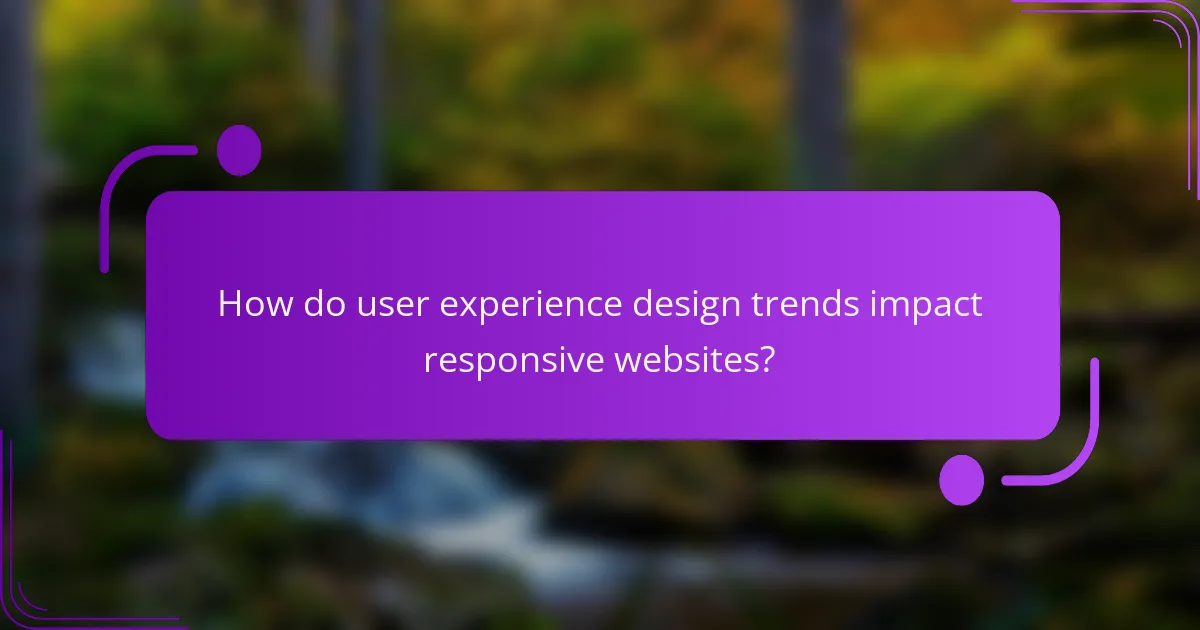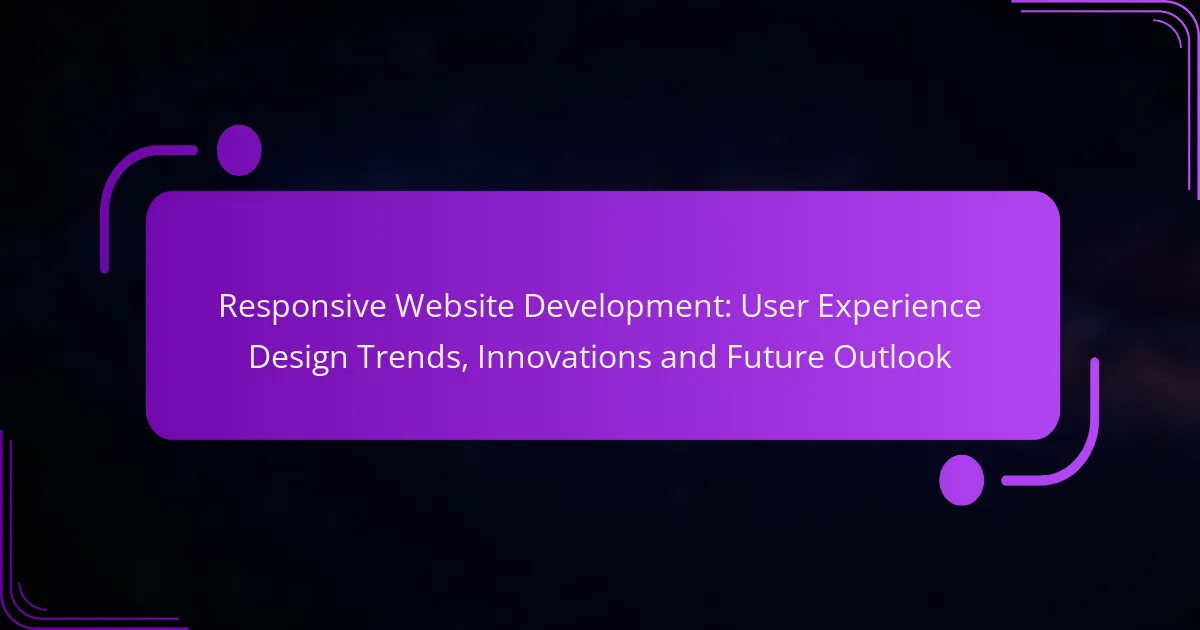Responsive website development is essential for ensuring a seamless user experience across diverse devices and screen sizes. By implementing strategies like mobile-first design and CSS media queries, developers can create engaging and effective websites that cater to modern user expectations. As innovations such as artificial intelligence and augmented reality continue to evolve, they promise to further enhance the responsiveness and interactivity of web design, shaping the future of user experience.

What are the best practices for responsive website development?
The best practices for responsive website development focus on creating a seamless user experience across various devices and screen sizes. Key strategies include mobile-first design, fluid grid layouts, flexible images, CSS media queries, and performance optimization techniques.
Mobile-first design
Mobile-first design prioritizes the mobile experience when developing websites. This approach ensures that the site is fully functional and visually appealing on smaller screens before scaling up for larger devices.
To implement mobile-first design, start by designing for the smallest screen size and progressively enhance the layout for larger screens. This helps streamline content and functionality, making it easier for users to navigate.
Fluid grid layouts
Fluid grid layouts use relative units like percentages instead of fixed units like pixels, allowing elements to resize based on the screen size. This flexibility ensures that your website maintains its structure and usability across different devices.
When designing a fluid grid, consider the overall layout and how elements will adjust. Aim for a balanced distribution of space, which can be achieved by using CSS frameworks that support fluid grids, such as Bootstrap or Foundation.
Flexible images and media
Flexible images and media adapt to the size of their container, preventing overflow and ensuring that visuals remain clear and proportional. This can be achieved by setting the maximum width of images to 100% in CSS.
To enhance user experience, use responsive image techniques like the srcset attribute, which allows browsers to select the appropriate image size based on the device’s resolution and screen size.
CSS media queries
CSS media queries enable developers to apply different styles based on the characteristics of the device, such as screen width, height, or orientation. This allows for tailored designs that improve usability and aesthetics on various devices.
When using media queries, define breakpoints that correspond to common device sizes, such as 480px for mobile, 768px for tablets, and 1024px for desktops. This helps ensure that your website looks great on all platforms.
Performance optimization techniques
Performance optimization techniques are crucial for responsive websites to ensure fast loading times and a smooth user experience. Strategies include minimizing HTTP requests, optimizing images, and leveraging browser caching.
Consider using tools like Google PageSpeed Insights to identify performance bottlenecks. Additionally, aim for loading times under 3 seconds, as this is generally considered an acceptable threshold for user satisfaction.

How do user experience design trends impact responsive websites?
User experience design trends significantly influence the effectiveness and appeal of responsive websites. By adopting modern design principles, developers can enhance usability, engagement, and overall satisfaction across various devices.
Minimalist design principles
Minimalist design principles focus on simplicity and functionality, stripping away unnecessary elements to create a clean user interface. This approach helps users navigate responsive websites more intuitively, reducing cognitive load and improving overall experience.
Key aspects of minimalist design include ample white space, limited color palettes, and straightforward typography. For instance, using a single primary color with contrasting accents can create a visually appealing layout that guides users’ attention effectively.
Micro-interactions
Micro-interactions are subtle animations or design elements that provide feedback or enhance user engagement on responsive websites. These small interactions, such as button hover effects or loading animations, can significantly improve the user experience by making interactions feel more dynamic and responsive.
To implement effective micro-interactions, consider the context and purpose of each element. For example, a simple animation that indicates a successful form submission can reassure users and encourage further interaction. However, avoid overusing animations, as excessive movement can distract or frustrate users.
Voice user interface integration
Integrating voice user interfaces (VUIs) into responsive websites allows users to interact using voice commands, enhancing accessibility and convenience. This trend is particularly relevant as smart speakers and voice assistants become more prevalent in everyday life.
When designing for VUIs, focus on natural language processing and ensure that the website can understand and respond to user queries effectively. For example, implementing voice search can help users find information quickly, but it’s essential to provide clear visual cues for users who may prefer traditional navigation methods.

What innovations are shaping the future of responsive web design?
Innovations such as artificial intelligence, augmented reality, and progressive web apps are significantly influencing the future of responsive web design. These technologies enhance user experience by providing personalized interactions, immersive environments, and seamless performance across devices.
Artificial intelligence in UX design
Artificial intelligence (AI) is transforming user experience (UX) design by enabling personalized content and adaptive interfaces. AI algorithms analyze user behavior to tailor experiences, suggesting products or content based on individual preferences. This can lead to increased engagement and conversion rates.
When implementing AI in web design, consider using chatbots for customer support or recommendation engines to enhance product discovery. However, ensure that AI tools are transparent and respect user privacy to maintain trust.
Augmented reality applications
Augmented reality (AR) applications are becoming essential in creating immersive user experiences. By overlaying digital information onto the real world, AR can enhance product visualization, allowing users to interact with items before purchase. For example, furniture retailers use AR to let customers see how a piece fits in their home.
To effectively integrate AR into responsive web design, focus on optimizing loading times and ensuring compatibility across various devices. Keep in mind that AR experiences should be intuitive and not overwhelming, providing clear guidance for users.
Progressive web apps
Progressive web apps (PWAs) combine the best of web and mobile applications, offering fast loading times and offline capabilities. They provide a native app-like experience while being accessible through a web browser, making them a cost-effective solution for businesses. PWAs can significantly improve user retention and engagement.
When developing a PWA, prioritize responsive design principles to ensure compatibility across devices. Implement service workers for offline functionality and push notifications to keep users informed. Avoid overly complex features that may hinder performance or user experience.

What are the key criteria for selecting a responsive web development agency?
When selecting a responsive web development agency, focus on their experience, client satisfaction, and technical capabilities. A well-rounded agency should demonstrate a strong portfolio, positive testimonials, relevant expertise, and ongoing support after the project is completed.
Portfolio evaluation
Reviewing an agency’s portfolio is essential to assess their design style and technical proficiency. Look for projects that showcase responsive design across various devices and industries. A diverse portfolio indicates adaptability and experience in meeting different client needs.
Pay attention to the complexity and functionality of the websites they have developed. Successful projects should not only look good but also provide seamless user experiences. Consider asking for case studies that detail the challenges faced and solutions implemented.
Client testimonials
Client testimonials provide insight into the agency’s reliability and customer service. Look for feedback that highlights the agency’s communication, adherence to deadlines, and overall satisfaction with the final product. Positive reviews can help gauge how well the agency collaborates with clients.
Consider reaching out to past clients for direct feedback. This can reveal valuable information about the agency’s strengths and weaknesses, helping you make a more informed decision.
Technical expertise
Technical expertise is crucial for a responsive web development agency. Ensure they are proficient in modern web technologies, such as HTML5, CSS3, JavaScript frameworks, and content management systems like WordPress or Drupal. Familiarity with SEO best practices is also important for visibility.
Check if the agency follows industry standards and best practices, such as accessibility guidelines (WCAG) and performance optimization techniques. A technically sound agency will ensure your website is not only visually appealing but also functional and compliant.
Post-launch support
Post-launch support is a key factor in maintaining your website’s performance and security. Inquire about the agency’s policies for updates, bug fixes, and ongoing maintenance. A good agency should offer a clear plan for support after the project is completed.
Consider the availability of support services, such as training for your team or troubleshooting assistance. This ongoing relationship can be vital for adapting to changes in technology or user needs over time.

How can businesses in the UK leverage responsive web design?
Businesses in the UK can leverage responsive web design by ensuring their websites adapt seamlessly to various devices, enhancing user experience and accessibility. This approach not only improves customer satisfaction but also boosts search engine rankings, making it essential for modern digital strategies.
Local SEO benefits
Responsive web design significantly enhances local SEO efforts by providing a consistent user experience across devices. Search engines like Google prioritize mobile-friendly sites, which can lead to higher visibility in local search results.
To maximize local SEO, businesses should ensure their contact information is easily accessible and that their site loads quickly on mobile devices. Implementing structured data markup can also help search engines better understand the content and context of the site.
Enhanced mobile user engagement
Responsive web design fosters enhanced mobile user engagement by creating a seamless browsing experience. Users are more likely to stay on a site that is easy to navigate and visually appealing on their smartphones or tablets.
To improve engagement, businesses should focus on optimizing images and reducing load times. Incorporating touch-friendly elements, such as larger buttons and simplified menus, can also encourage users to interact more with the content.
Competitive advantage in digital marketing
Implementing responsive web design provides a competitive advantage in digital marketing by ensuring that businesses can reach their audience effectively across all devices. Companies with mobile-optimized websites often outperform competitors who do not prioritize this aspect.
To capitalize on this advantage, businesses should regularly analyze user behavior and site performance on different devices. Staying updated with the latest design trends and technologies can help maintain a modern and appealing online presence.

What are the pricing ranges for responsive website development services?
The pricing for responsive website development services typically ranges from a few hundred to several thousand dollars, depending on project complexity and specific requirements. Basic websites may start around $1,000, while more advanced projects can exceed $10,000.
Factors Influencing Pricing
Several factors can influence the cost of responsive website development. These include the complexity of the design, the number of pages, the integration of custom features, and the level of expertise required from the developers. For instance, a simple, template-based site will generally be less expensive than a fully customized solution.
Additionally, the choice between hiring freelancers, agencies, or in-house teams can significantly affect pricing. Freelancers may offer lower rates, while agencies often provide a broader range of services and support, which can justify higher costs.
Typical Price Ranges
For basic responsive websites, prices usually range from $1,000 to $5,000. Mid-range projects that require more custom features and design elements can cost between $5,000 and $15,000. High-end, complex websites with extensive functionalities and tailored designs often start at $15,000 and can go well beyond $50,000.
It’s essential to clarify what is included in the quoted price, such as ongoing maintenance, SEO optimization, and support, as these factors can add significant value to the overall project.
Budgeting Tips
When budgeting for responsive website development, consider setting aside 10-20% of your total budget for unexpected costs. This will help accommodate any additional features or changes that may arise during the development process.
Additionally, prioritize your must-have features versus nice-to-have elements. This approach allows you to create a more focused project scope, potentially saving costs while still achieving a functional and attractive website.
